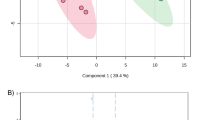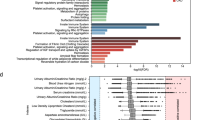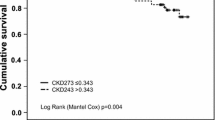Summary
Purpose
The purpose of this work is to examine the serum proteomic profiles associated with the subsequent development of diabetic nephropathy (DN) in patients with type 2 diabetes and to develop and validate a decision tree based on the profiles to predict the risk of DN in advance by albuminuria.
Methods
Surface-enhanced laser desorption/ionization time-of-flight mass spectrometry was used to obtain the proteomic profiles from baseline serum samples of 84 patients with type 2 diabetes with normal albuminuria, including 42 case subjects who developed DN after 4 years and 42 control subjects who remained normoalbuminuric over the same 4 years. From signatures of protein mass, a decision tree was established for predicting DN.
Results
At baseline, urinary albumin/creatinine ratio was similar between the case and control groups. The intensities of 5 peaks detected by CM10 chips appeared up-regulated, whereas 18 peaks were down-regulated more than twofold in the case group than compared with the control group in the training set. An optimum discriminatory decision tree for case subjects created with four nodes using four distinct masses was challenged with testing set. The positive predictive value was 77.8 % (7/9), and the negative predictive value was 72.7 % (8/11).
Conclusions
We developed and validated a decision tree to predict DN in patients with type 2 diabetes.
Zusammenfassung
Ziel der Studie
war es zu untersuchen, ob das Serum Proteomprofil mit der Entwicklung einer diabetischen Nephropathie (DN) bei Patienten mit Diabetes mellitus. Typ 2 im Zusammenhang steht. Ein weiteres Ziel war es, einen Entscheidungsbaum, der auf dem Proteomprofil basiert, zu entwickeln und zu validieren. Dieser sollte das Risiko einer DN durch Albuminurie voraussagen.
Methoden
Die Surface-enhanced Laser desorption/ionization time-of-flight Massenspektrometrie (SELDI-TOF-MS) wurde verwendet, um Proteomprofile in den Sera von 84 Patienten mit Typ 2 Diabetes mit normaler Albuminurie zu bestimmen. 42 dieser Patienten entwickelten eine DN innerhalb der nächsten 4 Jahre, die anderen 42 nicht. Aus den Signaturen der Proteinmasse wurde ein Entscheidungsbaum zur Vorhersage einer DN erstellt.
Ergebnisse
Zu Beginn waren die Albumin/Kreatinin Quotienten im Harn bei beiden Gruppen ähnlich. Die Intensität von 5 durch CM10 Chips entdeckten Peaks schienen hoch reguliert, während 18 Peaks in der Gruppe mit DN im Vergleich mit der Kontrolle mehr als zweifach down-reguliert waren. Unter Verwendung von 4 Knoten mit 4 unterschiedlichen Massen wurde zur optimalen Unterscheidung ein Entscheidungsbaum für die Patienten mit DN geschaffen und getestet. Der positive Vorhersagewert lag bei 77,8 % (7/9), der negative Vorhersagewert bei 72,7 % (8/11).
Schlussfolgerungen
Wir entwickelten und validierten einen Entscheidungsbaum, um das Auftreten einer DN bei Patienten mit Typ 2 Diabetes mellitus vorherzusagen.



Similar content being viewed by others
References
Nitsch D, Burden R, Steenkamp R, et al. Patients with diabetic nephropathy on renal replacement therapy in England and Wales. Nephrol Dial Transplant. 2007;100:551–60.
Amaresan MS, Geetha R. Early diagnosis of CKD and its prevention. J Assoc Physicians India. 2008;56:41–6.
Cerasola G, Cottone S, Mulè G. The progressive pathway of microalbuminuria: from early marker of renal damage to strong cardiovascular risk predictor. J Hypertens. 2010;28:2357–69.
Otu HH, Can H, Spentzos D, et al. Prediction of diabetic nephropathy using urine proteomic profiling 10 years prior to development of nephropathy. Diabetes Care. 2007;30:638–43.
Yang YH, Zhang S, Cui JF, et al. Diagnostic potential of serum protein pattern in Type 2 diabetic nephropathy. Diabet Med. 2007;24:1386–92.
Lu B, Song X, Dong X, et al. High prevalence of chronic kidney disease in population-based patients diagnosed with type 2 diabetes in downtown Shanghai. J Diabetes Complications. 2008;22:96–103.
Adam BL, Qu Y, Davis JW, et al. Serum protein fingerprinting coupled with a pattern-matching algorithm distinguishes prostate cancer from benign prostate hyperplasia and healthy men. Cancer Res. 2002;62:3609–14.
Vergouwe Y, Soedamah-Muthu SS, Zgibor J, Chaturvedi N, et al. Progression to microalbuminuria in type 1 diabetes: development and validation of a prediction rule. Diabetologia. 2010;53:254–62.
Choudhury D, Tuncel M, Levi M. Diabetic nephropathy—a multifaceted target of new therapies. Discov Med. 2010;10:406–15.
Long J, Wang Y, Wang W. MicroRNA-29c is a signature microRNA under high glucose conditions that targets Sprouty homolog 1, and its in vivo knockdown prevents progression of diabetic nephropathy. J Biol Chem. 2011;286:11837–48.
Papale M, Di Paolo S, Magistroni R, et al. Urine proteome analysis may allow noninvasive differential diagnosis of diabetic nephropathy. Diabetes Care. 2010;33:2409–15.
Acknowledgments
The study was funded by grants to Yehong Yang from the National Nature Science Foundation of China (81000329) and the Youth Science Foundation of Shanghai Health Bureau(2008Y040). The study was also funded by grants to Renming Hu from the Shanghai Science and Technology Commission (04DZ19504) and from the Key Project of National Nature Science Foundation of China (30230380), by grants to Shuo Zhang from the National Nature Science Foundation of China(30900541), by grants to Wei Gong from the National Nature Science Foundation of China(30900695), and by grants to Bin Lu from the National Nature Science Foundation of China(30900501).
Conflict of interest
The authors declare that they have no conflict of interest.
Author information
Authors and Affiliations
Corresponding author
Additional information
Yehong Yang and Shuo Zhang contributed equally to this work.
Rights and permissions
About this article
Cite this article
Yang, Y., Zhang, S., Lu, B. et al. Predicting diabetic nephropathy by serum proteomic profiling in patients with type 2 diabetes. Wien Klin Wochenschr 127, 669–674 (2015). https://doi.org/10.1007/s00508-014-0679-1
Received:
Accepted:
Published:
Issue Date:
DOI: https://doi.org/10.1007/s00508-014-0679-1
Keywords
- Diabetic nephropathy
- Proteomic profiling
- Prediction
- Surface-enhanced laser desorption/ionization
- Decision tree




